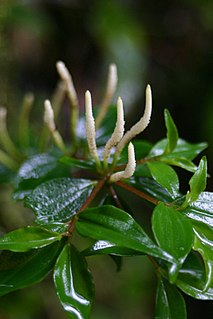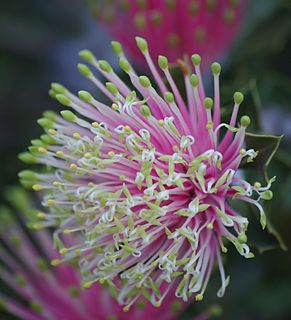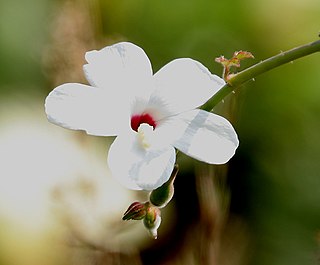
Peperomia is one of the two large genera of the family Piperaceae. Most of them are compact, small perennial epiphytes growing on rotten wood. More than 1500 species have been recorded, occurring in all tropical and subtropical regions of the world, though concentrated in Central America and northern South America. A limited number of species are found in Africa.

Convolvulaceae, known commonly as the bindweed or morning glory family, is a family of about 60 genera and more than 1,650 species of mostly herbaceous vines, but also trees, shrubs and herbs, and also including the sweet potato and a few other food tubers.

Morning glory is the common name for over 1,000 species of flowering plants in the family Convolvulaceae, whose current taxonomy and systematics are in flux. Morning glory species belong to many genera, some of which are:

Ergine, also known as d-lysergic acid amide (LSA) and d-lysergamide, is an ergoline alkaloid that occurs in various species of vines of the Convolvulaceae and some species of fungi. The psychedelic properties in the seeds of ololiuhqui, Hawaiian baby woodrose and morning glories have been linked to ergine and/or isoergine, its epimer, as it is the dominant alkaloid present in the seeds.

Solanum dulcamara is a species of vine in the potato genus Solanum, family Solanaceae. Common names include bittersweet, bittersweet nightshade, bitter nightshade, blue bindweed, Amara Dulcis, climbing nightshade, fellenwort, felonwood, poisonberry, poisonflower, scarlet berry, snakeberry, trailing bittersweet, trailing nightshade, violet bloom, and woody nightshade.

Ergoline is a chemical compound whose structural skeleton is contained in a variety of alkaloids, referred to as ergoline derivatives or ergoline alkaloids. Ergoline alkaloids, one being ergine, were initially characterized in ergot. Some of these are implicated in the condition ergotism, which can take a convulsive form or a gangrenous form. Even so, many ergoline alkaloids have been found to be clinically useful. Annual world production of ergot alkaloids has been estimated at 5,000–8,000 kg of all ergopeptines and 10,000–15,000 kg of lysergic acid, used primarily in the manufacture of semi-synthetic derivatives.

Lysergic acid, also known as D-lysergic acid and (+)-lysergic acid, is a precursor for a wide range of ergoline alkaloids that are produced by the ergot fungus and found in the seeds of Turbina corymbosa (ololiuhqui), Argyreia nervosa, and Ipomoea tricolor. Amides of lysergic acid, lysergamides, are widely used as pharmaceuticals and as psychedelic drugs (LSD). Lysergic acid received its name as it was a product of the lysis of various ergot alkaloids.

Argyreia nervosa is a perennial climbing vine native to the Indian subcontinent and introduced to numerous areas worldwide, including Hawaii, Africa, and the Caribbean. Though it can be invasive, it is often prized for its aesthetic and medicinal value. Common names include Hawaiian baby woodrose, adhoguda अधोगुडा or vidhara विधारा (Sanskrit), elephant creeper and woolly morning glory. Its seeds are known for their powerful entheogenic value, greater or similar to those of varieties from the Convolvulaceae family, with users reporting significant psychedelic and spiritual experiences. The two botanical varieties are A. n. var. nervosa described here, and A. n. var. speciosa, which are used in Ayurvedic medicine for their medicinal value.

Banksia cuneata, commonly known as matchstick banksia or Quairading banksia, is an endangered species of flowering plant in the family Proteaceae. Endemic to southwest Western Australia, it belongs to Banksia subg. Isostylis, a sub-genus of three closely related Banksia species with inflorescences or flower clusters that are dome-shaped heads rather than characteristic Banksia flower spikes. A shrub or small tree up to 5 m (16 ft) high, it has prickly foliage and pink and cream flowers. The common name Matchstick Banksia arises from the blooms in late bud, the individual buds of which resemble matchsticks. The species is pollinated by honeyeaters (Meliphagidae).

D-Lysergic acid α-hydroxyethylamide, also known as D-lysergic acid methyl carbinolamide, is an alkaloid of the ergoline family, believed to be present in small amounts in various species in the Convolvulaceae (LSA), as well as some species of fungi.

Lysergol is an alkaloid of the ergoline family that occurs as a minor constituent in some species of fungi, and in the morning glory family of plants (Convolvulaceae), including the hallucinogenic seeds of Rivea corymbosa (ololiuhqui), Argyreia nervosa and Ipomoea violacea. Lysergol is not a controlled substance in the USA. Its possession and sale is also legal under the U.S. Federal Analog Act because it does not have a known pharmacological action or a precursor relationship to LSD, which is a controlled substance. However, lysergol is an intermediate in the manufacture of some ergoloid medicines.

Jateorhiza palmata (calumba) is a perennial climbing plant from East Africa. It contains isoquinoline alkaloids and is used mainly as a bitter tonic especially in cases of anorexia nervosa. It contains no tannins, hence it can be safely used in iron preparations for the treatment of anaemia without the fear of precipitation resulted from in vitro interaction.

Ipomoea indica is a species of flowering plant in the family Convolvulaceae, known by several common names, including blue morning glory, oceanblue morning glory, koali awa, and blue dawn flower. It bears heart-shaped or 3-lobed leaves and purple or blue funnel-shaped flowers 6–8 cm (2–3 in) in diameter, from spring to autumn. The flowers produced by the plant are hermaphroditic.

Solanum atropurpureum, commonly known as malevolence, purple devil and the five-minute plant, is a perennial herbaceous plant native to Brazil. S. atropurpureum contains various toxic tropane alkaloids in its fruit, stems, and leaves, and should not be ingested.

Abelmoschus ficulneus is a species of flowering plant in the genus Abelmoschus, family Malvaceae. Commonly known as white wild musk mallow or native rosella, it is fibrous perennial with a woody stem. Its flowers are about an inch in diameter, either pink or white, with a rose center; its leaves are palmate.

Astragalus mollissimus is a perennial plant in the legume family (Fabaceae) found in the Colorado Plateau and Canyonlands region of the southwestern United States.
Mandragora caulescens, the Himalayan mandrake, is a perennial herbaceous plant in the family Solanaceae, native to the Himalayas and mountainous regions of Myanmar and south-west China. One of the differences from the other species of Mandragora is that it has a stem, whereas they are stemless. Like all species of Mandragora, it contains tropane alkaloids, making it toxic. It is used in traditional Chinese medicine.

Vexatorella amoena, also known as the Swartruggens vexator is an evergreen shrub of up to about 1 m (3 ft) high, that is assigned to the family Proteaceae. It has entire, inverted egg-shaped, bluish grey, leathery leaves of 1½–3 cm (0.6–1.2 in) long and 5–11 mm (0.20–0.45 in) wide on a distinct stalk, and globular flower heads of about 2 cm (0.8 in) across with pale pink flowers with extended, thick-tipped styles at the tip of the branches. The plants are flowering from September to November. It is an endemic species that is restricted to the Western Cape province of South Africa.

Mimetes stokoei, the mace pagoda, is an evergreen, upright, hardly branching, large shrub of 1–2 m high in the family Proteaceae. It has silvery, oval leaves of 5–8 cm (2.0–3.2 in) long and 2 1⁄2–4 cm (1.0–1.6 in) wide, with one large tooth supported by two smaller teeth near the tip, at an upward angle and somewhat overlapping each other. The inflorescences are set just below the growing tip, are cylinder-shaped, 10–12 cm (4–5 in) high, topped by a crest of small, more or less horizontal, pinkish-purple tinged leaves. It consists of several flower heads in the axils of golden leaves with a pinkish wash that form a hood shielding the underlying flower head. Each flower head contains eight to twelve individual flowers, with amber-colored styles topped by blackish purple pollen presenters and grey silky perianth lobes. It is endemic to the Fynbos ecoregion of South Africa, being confined to the Kogelberg mountain range. The mace pagoda was twice presumed extinct, but reappeared in its natural habitat from seed, after a wildfire several decades later.

Jovellana sinclairii, commonly known as the New Zealand calceolaria, is an Endemic New Zealand shrub found in eastern and central North Island forests. In the family Calceolariaceae, it has white, bell shaped flowers with spots of purple on the inside.



















